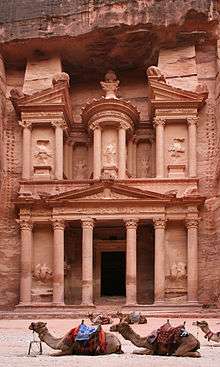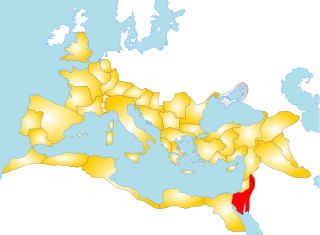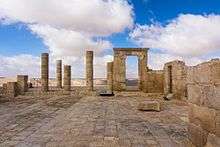Nabataean Kingdom
| Nabataean Kingdom | ||||||||||
| المملكة النبطية | ||||||||||
| ||||||||||
.svg.png) The Nabataean Kingdom at its greatest extent | ||||||||||
| Capital | Petra | |||||||||
| Languages | Nabataean Arabic | |||||||||
| Religion | Arab polytheism | |||||||||
| Government | Monarchy | |||||||||
| King | ||||||||||
| • | 168–144 BC | Aretas I | ||||||||
| • | 140–120 BC | Rabbel I | ||||||||
| • | 120–96 BC | Aretas II | ||||||||
| • | 96–86 BC | Obodas I | ||||||||
| • | 86–62 BC | Aretas III | ||||||||
| • | 62–59 BC | Obodas II | ||||||||
| • | 59–30 BC | Malichus I | ||||||||
| • | 30–9 BC | Obodas III | ||||||||
| • | 9 BC– 40 AD | Aretas IV | ||||||||
| Historical era | Antiquity | |||||||||
| • | Established | 4th century BC | ||||||||
| • | Obodas I repels Hasmonean invasion | 90 BC | ||||||||
| • | Conquered by the Roman Empire | 106 AD | ||||||||
| Area | 200,000 km² (77,220 sq mi) | |||||||||
| Currency | Nabataean Denarius | |||||||||
| ||||||||||
| Today part of | | |||||||||
The Nabataean Kingdom (Arabic: المملكة النبطية), also named Nabatea, was a political state of the Arab Nabataeans during classical antiquity.
Nabataea remained independent from the 4th century BC until It was annexed by the Roman Empire in AD 106, which renamed it Arabia Petrea.[1]
History
Nabataeans
The Nabataeans were one among several nomadic Bedouin tribes that roamed the Arabian Desert and moved with their herds to wherever they could find pasture and water.[2] They became familiar with their area as seasons passed, and they struggled to survive during bad years when seasonal rainfall diminished.[2] Although the Nabataeans were initially embedded in Aramaic culture, theories about them having Aramean roots are rejected by modern scholars. Instead, archaeological, religious and linguistic evidence confirm that they are a northern Arabian tribe.[3]
The precise origin of the specific tribe of Arab nomads remains uncertain. One hypothesis locates their original homeland in today's Yemen, in the southwest of the Arabian peninsula, but their deities, language and script share nothing with those of southern Arabia. Another hypothesis argues that they came from the eastern coast of the peninsula.[2]
The suggestion that they came from the Hejaz area is considered to be more convincing, as they share many deities with the ancient people there; nbtw, the root consonant of the tribe's name, is found in the early Semitic languages of Hejaz.[2]
Similarities between late Nabataean Arabic dialect and the ones found in Mesopotamia during the Neo-Assyrian period, as well as a group with the name of "Nabatu" being listed by the Assyrians as one of several rebellious Arab tribes in the region, suggests a connection between the two.[2] The Nabataeans might have originated from there and migrated west between the 6th and 4th centuries BC into northwestern Arabia and much of what is now modern-day Jordan.[2]
Nabataeans have been falsely associated with other groups of people. A people called the "Nabaiti", who were defeated by the Assyrian king Ashurbanipal, were associated by some with the Nabataeans because of the temptation to link their similar names. Another misconception is their identification with the Nebaioth of the Hebrew Bible, the descendants of Ishmael, Abraham's son.[2]
Unlike the rest of the Arabian tribes, the Nabataeans later emerged as vital players in the region during their times of prosperity. However, their influence then faded, and the Nabataeans were forgotten.[2]
Emergence

Although the Nabataeans were literate, they left no lengthy historical texts. However, there are thousands of inscriptions still found today in several places where they once lived, including graffiti and on their minted coins.[2] The first historical reference to the Nabataeans is by Greek historian Diodorus Siculus who lived around 30 BC, but he includes some 300 years earlier information about them.[2] He uses a source by Hieronymus of Cardia; one of Alexander the Great's generals who had a first-hand encounter with the Nabataeans.[2]
Diodorus relates how the Nabataeans survive in a waterless desert and how they managed to defeat any enemies by hiding in the desert until the latter would surrender for lack of water.[2] The Nabataeans dug cisterns that were covered and left signs known only to themselves.[2] Diodorus wrote about how they were "exceptionally fond of freedom" and includes an account about unsuccessful raids that were initiated by Greek general Antigonus I in 312 BC.[2]
neither the Assyrians of old, nor the kings of the Medes and Persians, nor yet those of the Macedonians have been able to enslave them, and... they never brought their attempts to a successful conclusion. - Diodorus[2]
After Alexander the Great's death in 323 BC, his empire split among his generals. During the conflict between Alexander's generals, Antigonus I conquered the Levant and this brought him to the borders of Edom, just north of Petra.[2] The wealthy Nabataeans became Antigonus's next target, their wealth was generated by revenues from the trade caravans that transported frankincense, myrrh and other spices from Eudaemon in today's Yemen, across the Arabian peninsula, passing through Petra and ending up in the Port of Gaza for shipment to European markets.[2] This wealth distinguished the Nabataeans from other Arab tribes.[4] Antigonus appointed one of his officers to attack the Nabataean "barbarians" and take their herds as booty. The three raids either came to nothing or ended up in disaster for the Greeks.[5]
In the first raid, the Greeks managed to loot tonnes of spices and silver from Petra in 312 BC; although the year is regarded as the official start of Nabataean history, they were already wealthy.[2] Two confrontations soon followed and in light of the defeats, Antigonus deserted his plans against these Arabs, as he had more important matters to attend to. During the Battle of Ipsus in Anatolia around 301 BC, Antigonids lost to a Greek coalition that included the Seleucids.[2]
The series of wars between the Greek generals ended in a dispute over the lands of modern-day Jordan between the Ptolemies based in Egypt and the Seleucids based in Syria. The conflict enabled the Nabataeans to extend their kingdom beyond Edom.[6]
Kingdom

During the late fourth century BC, the Nabataeans occupied northern Hejaz, Edom and the Negev into the Mediterranean Sea. Along with some offshore islands and a stretch of land along the coast of the Red Sea.[2] Diodorus mentions that the Nabataeans had attacked merchants ships belonging to the Ptolemies in Egypt but were soon targeted by a larger force and "punished as they deserved".[2] While it is unknown why the wealthy Nabataeans turned to piracy, one possible reason is that they felt that their trade interests were threatened by the competitive naval trade route across the Red Sea.[2]
Half a century following Antigonus's aggressions is the second historical reference to the Nabataeans in Hauran.[2] Dionysius, one of two Greek employees who sought an alternative career of selling women as sex slaves, was once detained by the Nabataeans for a week during one of his trades.[2] Considering the Nabtaean society's remarkable gender equality at that time, it is likely that they were objecting to the treatment of women in their area, which they believed they were responsible for in the course of maintaining law and order.[2]
Aretas I is the first named king of the Nabataeans whose name was found on an inscription in the Negev dating back to the second century BC.[2] Around the same time, the Arab Nabataeans and the neighboring Jewish Maccabees had maintained a friendly relationship, the former had sympathized with the Maccabee who were being mistreated by the Seleucids.[2] The Nabataeans started to mint coins during the same century, portraying the extensive economic and political independence that they enjoyed.[2]
Petra was included in a list of major cities in the Mediterranean area to be visited by a notable from Priene, a sign of the significance of Nabataea in the ancient world. Petra was included with Alexandria, which was considered to be a supreme city in the civilized world.[2]
Nabataeans and Hasmoneans
The Nabataeans were allies of the Maccabees during their struggles against the Seleucid monarchs. They then became rivals of their successors, the Judaean Hasmonean dynasty, and a chief element in the disorders which invited Pompey's intervention in Judea.[7] The Port of Gaza was the last stop for spices that were carried by trade caravans before shipment to European markets, and so the Nabataeans had considerable influence over the Gazans.[2] The Hasmonean King Alexander Jannaeus, besieged the city of Gaza around 100 BC, on the grounds that the Gazans had favoured the Ptolemies over the Judaeans in their recent battles. Gaza was occupied and its inhabitants put to the sword by Jannaeus.[2]
The Hasmoneans, under Jannaeus, launched a campaign that captured several territories in Transjordan north of Nabataea, along the road to Damascus, including northern Moab and Gilead. The territorial acquisitions threatened Nabataean trade interests, both to Gaza and to the Seleucids in Damascus.[8] The Nabataean King, Obodas I fought to restore the areas. Obodas managed to defeat Jannaeus in the Battle of Gadara around 93 BC, when he ambushed him and his forces in a steep valley where Jannaeus "was lucky to escape alive".[2]
After the Nabataean victory over the Judaeans, the former were now at odds with the Seleucids, who were not impressed with the increasing influence of the Nabataeans to the south of their territories.[9] The Nabataeans were again victorious over the Greeks, and this time over the Seleucids. During the Battle of Cana, the Seleucid king Antiochus XII waged war against the Nabataeans and the king himself was slain during combat. His demoralized army fled and perished in the desert from starvation. After Obodas's victories over the Judaeans and the Greeks, he became the first Nabataean king to be worshipped as a god by his people.
Avdat was a temple built in the Negev desert by the Nabataeans to commemorate Obodas. He was buried there and inscriptions have been found referring to "Obodas the god".[2]
During the reign of Aretas III (87 to 62 BC) the kingdom seems to have reached its territorial zenith, but it was defeated by a Roman army under the command of Marcus Aemilius Scaurus. Scaurus' army even besieged Petra, but eventually a compromise was negotiated.
Paying a tribute, Aretas III received the formal recognition by the Roman Republic.[10]
The Nabataean kingdom saw itself slowly surrounded by the expanding Roman Empire, which conquered Egypt and annexed Hasmonean Judea. While the Nabataean kingdom managed to preserve its formal independence, it became a client kingdom under the influence of Rome.[10]
Roman annexation

In 106 AD, during the reign of Roman emperor Trajan, the last king of the Nabataean kingdom Rabbel II Soter died.[10] That might have prompted the official annexation of Nabatea to the Roman Empire, but the formal reasons and the exact manner of annexation are unknown.[10]
Some epigraphic evidence suggests a military campaign, commanded by Cornelius Palma, the governor of Syria. Roman forces seem to have come from Syria and also from Egypt. It is clear that by 107 AD Roman legions were stationed in the area around Petra and Bostra, as is shown by a papyrus found in Egypt. The kingdom was annexed by the empire to become the province of Arabia Petraea. Trade seems to have largely continued thanks to the Nabataeans' undiminished talent for trading.[10]
Under Hadrian, the limes Arabicus ignored most of the Nabatæan territory and ran northeast from Aila (modern Aqaba) at the head of the Gulf of Aqaba. A century later, during the reign of Alexander Severus, the local issue of coinage came to an end. There was no more building of sumptuous tombs, apparently because of a sudden change in political ways, such as an invasion by the neo-Persian power under the Sassanid Empire.
The city of Palmyra, for a time the capital of the breakaway Palmyrene Empire (fl. 130–270), grew in importance and attracted the Arabian trade away from Petra.[11][12]
Geography
It was between the Sinai Peninsula and the Arabian Peninsula. Its northern neighbour was the kingdom of Judea, and its south western neighbour was Ptolemaic Egypt. Its capital was the city of Raqmu in Jordan, and it included the towns of Bostra, Hegra, and Nitzana.
Raqmu, now called Petra, was a wealthy trading town, located at a convergence of several important trade routes. One of them was the Incense Route which was based around the production of both myrrh and frankincense in southern Arabia,[11][13] and ran through Mada'in Saleh to Petra. From there, aromatics were distributed throughout the Mediterranean region.
See also
References
- ↑ Ministry of Tourism & Antiquities - Petra from the official website for The Hashemite Kingdom of Jordan
- 1 2 3 4 5 6 7 8 9 10 11 12 13 14 15 16 17 18 19 20 21 22 23 24 25 26 27 28 29 30 31 32 33 Jane, Taylor (2001). Petra and the Lost Kingdom of the Nabataeans. London, United Kingdom: I.B.Tauris. pp. 14, 17, 30, 31. Retrieved 8 July 2016.
- ↑ Maalouf, Tony (2003). Arabs in the Shadow of Israel: The Unfolding of God's Prophetic Plan for Ishmael's Line. Kregel Academic. Retrieved 8 July 2016.
- ↑ Mills, Watson; Bullard, Roger (1990). Mercer Dictionary of the Bible. Mercer University Press. p. 598. Retrieved 9 July 2016.
- ↑ Waterfield, Robin (11 October 2012). Dividing the Spoils: The War for Alexander the Great's Empire. Oxford University Press. p. 123. Retrieved 10 July 2016.
- ↑ Salibi, Kamal (1998). The Modern History of Jordan. I.B.Tauris. p. 10. ISBN 978-1-86064-331-6. Retrieved 11 July 2016.
- ↑ Johnson, Paul (1987). A History of the Jews. London: Weidenfeld and Nicolson. ISBN 978-0-297-79091-4.
- ↑ Josephus, Flavius (1981). The Jewish War. 1:87. Trans. G. A. Williamson 1959. Harmondsworth, Middlesex, England: Penguin. p. 40. ISBN 978-0-14-044420-9.
- ↑ Ball, Warwick (10 June 2016). Rome in the East: The Transformation of an Empire. Routledge. p. 65. Retrieved 10 July 2016.
- 1 2 3 4 5 Taylor, Jane; Petra; p.25-31; Aurum Press Ltd; London; 2005; ISBN 9957-451-04-9
- 1 2 Teller, Matthew; Jordan; p.265; Rough Guides; Sept 2009; ISBN 978-1-84836-066-2
- ↑ "'Al Kanfei Yonah". Google Books. Retrieved 27 August 2014.
- ↑ Gibson (2011), p. 132.
| Wikimedia Commons has media related to Nabataean Kingdom. |
External links
- A map of the VIA NOVA TRAIANA showing the outposts that made up Hadrian's limes
Coordinates: 30°19′43″N 35°26′31″E / 30.3286°N 35.4419°E
